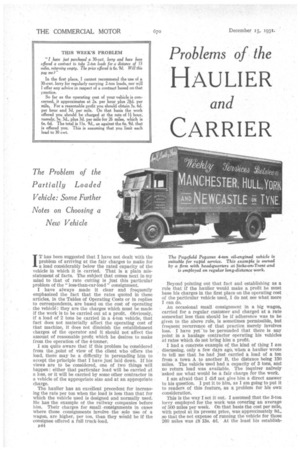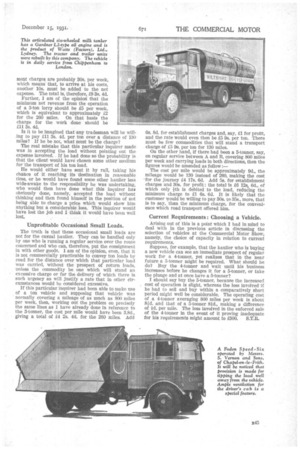Problems of the
Page 62

Page 63

If you've noticed an error in this article please click here to report it so we can fix it.
HAULIER
and
CARRIER
The Problem of the Partially Loaded Vehicle: Some Further Notes on Choosing a New Vehicle
IT has been suggested that I have not dealt with the problem of arriving at the fair charges to make for a load considerably below the rated capacity of the vehicle in which it is carried. That is a plain misstatement of facts. The subject that comes next in my mind to that of rate cutting is just this particular problem of the " less-than-car-load " consignment.
I have always made it clear and frequently emphasized the fact that the rates quoted in these articles, in the Tables of Operating Costs or in replies to correspondents, are based on the cost of operating the vehicle: they are the charges which must be made if the work is to be carried out at a profit. Obviously, if a load of 2 tons be carried in a 4-ton vehicle, that fact does not materially affect the operating cost of that machine, it does not diminish the establishment charges of the operator and it should not affect the amount of reasonable profit which lie desires to make from the operation of the 4-toriner.
I am quite aware that if this problem be considered from the .point of view of the client who offers the . load, there may be a difficulty in persuading him to accept the principle that I have just laid down. If his views are to be considered, one of two things will happen: either that particular load will be carried at a loss, or it will be carried by some other contractor in a vehicle of the appropriate size and at an appropriate charge. The haulier has an excellent precedent for increasing the rate per ton when the load is less than that for which the vehicle used is designed and normally used. He has the example of the railway companies before him. Their charges for small consignments in cases where those consignments involve the sole use of a wagon, are higher, per ton, than they would be if the consignee offered a full truck-load.
B44
Beyond pointing out that fact and establishing as a rule that if the haulier would make a profit he must base his charges in the first place on the operating cost of the particular vehicle used, I do not see what more I can do.
An occasional small consignment in a big wagon, carried for a regular customer and charged at a rate somewhat less than should be if adherence was to be given to the above rule, is sometimes permissible, but frequent recurrence of that practice merely involves loss. I have yet" to be persuaded that there is any point in a haulage contractor operating his vehicles at rates which do not bring him a profit.
I had a concrete example of the kind of thing I am discussing, only a few days ago, when a haulier wrote to tell me that he had just carried a load of a ton from a town A to another B, the distance being 130 miles. The vehicle used had a capacity of 3 tons, and no return load was available. The inquirer naively asked me what would be a fair charge for the work.
I am afraid that I did not give him a direct answer to his question. I put it to him, as I am going to put it to readers of this feature, as a problem for his own consideration.
This is the way I set it out. I assumed that the 3-ton lorry employed for the work was covering an average of 500 miles per week. On that basis the cost per mile, with petrol at its present price, was approximately 8d., so that the net expense of running the vehicle for those 260 miles was LS 13s. 4d. At the least his establish meat charges are probably 30s. per week, which means that, to arrive at his costs, another 10s. must be added to the net expense. The total is, therefore, 19 3s. 4d.
Further, I am of the opinion that the minimum net revenue from the operation of a 3-ton lorry should be £5 per week, which is equivalent to approximately £2 for the 260 miles. On that basis the charge for the work done should be £11 3s. 4d.
Is it to be imagined that any tradesman will be willlag to pay £11 3s. 4d. per ton over a distance of 130 miles? If he be not, what must be the charge?
The real mistake that this particular inquirer made was in accepting the load without pointing out the expense involved. If he had done so the probability is that the client would have chosen some other medium for the transport of his ton load.
He would either have sent it by rail, taking his chalice of it reaching its 'destination in reasonable time, or he would have found some other haulier less wide-awake to the responsibility he was undertaking, who would then have done what this inquirer has obviously done, namely, accepted the load without thinking and then found himself in the position of not being able to charge a price which would show him anything but a considerable loss. This inquirer would have lost the job and [think it would have been well lost.
Unprofitable Occasional Small Loads.
The truth is that these occasional small loads are not for the casual haulier. They can be handled only by one who is running a regular service over the route concerned and who can, therefore, put the consignment in with other goods. I am of the opinion, even, that it is not commercially practicable to convey ton loads by road for the distance over which that particular load was carried, without the prospect of return loads, unless the commodity be one which will stand an excessive charge or for the delivery of which there is such urgency as will justify a rate that in other circumstances would be considered excessive.
If this particular inquirer had been able to make use of a ton vehicle and supposing that vehicle was normally covering a mileage of as much as 800 miles per week, then, working out the problem on precisely the same lines as I have already done in reference to the 3-tonner, the cost per mile would have been 3.8d., giving a total of .£4 2s. 4d. for the 260 miles. Add
6s. 8d. for establishment charges and, say, £1 for protit, and the rate would even then be £5 9s. per ton. There must be few commodities that will stand a transport charge of 1:5 9s. per ton for 130 miles.
On the other hand, if there had been a 5-tonner, say, on regular service between A and B, covering 800 miles per week and carrying loads in both directions, then the figures would be amended as follow :— The cost per mile would be approximately 9d., the mileage would be 130 instead of 260, making the cost for the journey £4 17s. 6d. Add 5s. for establishment charges and 30s. for profit the total is £6 12s, 6d., of which only ith is debited to the load, reducing the minimum charge to £1 6s. 6d. It is likely that the customer would be willing to pay 30s. to 35s., more, that is to say, than the minimum charge, for the convenience which road transport offered him.
Current Requirements : Choosing a Vehicle.
Arising out of this is a point which I had in mind to deal with in the previous article in discussing the selection of vehicles at the Commercial Motor Show, namely, the choice of capacity in relation to current requirements.
Suppose, for example, that the haulier who is buying a new vehicle can see an immediate prospect of regular work for a 4-tonner, yet realizes that in the near future a 5-tormer might be required. What should he do? Buy the 4-tonner and wait until his business increases before he changes it for a 5-tonner, or take the plunge and at once have a 5-tonner?
I should say buy the 5-tonner, because the increased cost of operation is slight, whereas the loss involved if he had to sell and buy within a comparatively short period might well be considerable. The operating cost of a 4-tonner averaging 800 miles per week is about 8id. and that of a 5-tonner Sid., making a difference of id. per mile. The loss involved in the enforced sale of the 4-tonner in the event of it proving inadequate for his requirements might amount to £300. S.T.B..




































































































